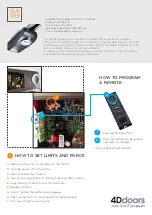
INSTALLATION: COMPONENT ASSEMBLY AND CONNECTION
––– STEP 5 –––
IMPORTANT!
- The following assembly steps illustrate installation of the WS100SK/
WS100SCK gearmotor.
- For correct system operation it is necessary to supply mechanical
stops, on the ground or wall, positioned at the maximum Opening and
Closing points of the door.
Note
- These end stops are not included in
the kit and do not form part of the Mhouse product range.
WARNINGS
• Incorrect installation may cause serious physical injury to those
working on or using the system.
• Before starting automation assembly, carry out the preliminary
checks as described in STEP 3
.
5.1 - WS100SCK AND WS100SK GEARMOTOR INSTAL-
LATION
01.
Measure distance “
B
” (
fig. 6
).
02.
Move the leaf to the desired maximum opening position, and check
whether the angle value found falls within the values listed in
Graph 4
.
03.
As shown in
fig. 4
, using value “
B
” and the opening angle, determine
value “
A
”.
Example: if “
B
” is 100mm and the angle required is equal
to 100°, the distance “
A
” is around 180 mm
.
04.
Affix the gearmotor mounting bracket to the wall, in a horizontal posi-
tion, as shown in
fig. 8
and
9
. Use suitable anchors, screws and
washers
(not supplied)
.
05.
Remove the mechanical stop located on the underside of the motor,
using a 13mm wrench (
fig. 11
): loosen and unscrew the self-locking
nut of the screw of the mechanical stop.
06.
Insert the back of the gearmotor into the space provided on the
mounting bracket, taking care to line up the holes on the motor with
those on the bracket (
fig. 12
).
07.
Support the gearmotor with one hand and with the other hand insert
the two screws supplied into the holes.
Note – If the screws do not
go in easily, use a hammer and a hex nut driver to insert them fully
(see
fig. 13
). Then, fasten the screws with suitable nuts; to do this,
use an Allen wrench to hold the head of the screw and a (10 mm) hex
nut screwdriver, with external dimensions not exceeding 14.5 mm, to
tighten the nut.
08.
Now, affix the curved arm to the gearmotor.
IMPORTANT! –
The arm
must be positioned with the curvature pointing towards the gate leaf.
Then align the holes on the two arms and insert the pin supplied and
the ringed stop. (
fig. 14
).
09.
To secure the attachment bracket to the gate leave, proceed in the
following way:
a)
Insert the bracket to the end of the curved arm, aligning the respec-
tive holes, and insert the pin supplied (without ring stop -
fig. 15
).
b)
Release the gearmotor using the required key (refer to chap-
ter “Manually releasing and locking the gearmotor” in the “Usage
Guide”).
c)
Move the gate leaf into the fully closed position required, and
extend the arm to its full length (
fig. 16
). Then, bring the latter to the
leaf, until the mounting bracket is fully locked onto it.
d)
Now, using a pencil, mark the drilling points and then drill the leaf
using a drill.
Note – The screws required for leaf-fixture of the bracket
are not included in the pack, as their type depends on the material
and thickness of the gate or door in which they are inserted.
10.
Detach the bracket from the arm of the gearmotor, and affix it to the
gate leaf.
Important
– Check that the bracket sits perfectly level.
11.
Attach the gearmotor arm to the bracket by inserting the pin and the
ring stop supplied.
12. CAUTION! – If, in your installation environment, there are no
mechanical stops placed on the ground, refer to STEP 5.2.
13.
Finally, still with the gearmotor released, manually move the two gate
leaves into the position shown in
fig. 17
and lock the gearmotor
using the appropriate key (refer to the chapter “Manually releasing
and locking the gearmotor” found in the “TECHNICAL DOCUMENTA-
TION” section). Now, using just a slight movement, move the gate
leaf a few centimetres in the direction of full opening, until you hear a
click.
14. If the gate to be automated is a dual leaf type, repeat the same
operations describe in this STEP 5 to also install the second
gearmotor.
5.2 - ADJUSTING THE OPENING MECHANICAL LIMIT
SWITCH
If, in your installation environment, there are no mechanical stops placed
on the ground, designed to stop the wings of the gate at the end of their
opening movement, it is necessary to adjust the mechanical stop on the
bottom side of each motor, in the following manner:
01.
With the gearmotor released, manually move the leaf to the Open
position.
02.
Locate the centrepoint (axis) of the gearmotor arm, and mark it using
a piece of adhesive tape placed in the fixed part of the gearmotor, above
the arm (
fig. 18
).
03.
Now close the gate leaf.
04.
In order to facilitate mounting the mechanical stop, we recommend
that you add a piece of adhesive tape, up to the base of the gearmotor,
as shown in
fig. 19
.
05.
Place the mechanical stop in the following way: if you are working on
the gearmotor that moves the left-hand leaf, the mechanical stop must
be fixed to the left of the adhesive tape, adjacent to it; conversely, if you
are working on the gearmotor on the right the mechanical stop should be
attached to the right of the adhesive tape, adjacent to it (
fig. 20
). Then
fasten it using its self-locking nut (
fig. 21
).
06.
Now, by moving the gate leaf manually, check that the latter stops
exactly at the desired maximum opening point. If this is not the case,
move the mechanical stop by one or two “teeth”; then check the maxi-
mum opening position again.
07.
Finally, with the gearmotor still released, manually move the gate leaf
to around half its travel, and lock the gearmotor
using the appropriate key (refer to chapter “Manually releasing and locking
the gearmotor” in the “Usage Guide”). Now, using just a slight movement,
move the gate leaf a few centimetres in the direction of full opening until
you hear a click.
5.3 - WS100SCK AND WS100SK GEARMOTOR CONNEC-
TION
CAUTION! – All electrical connections must be made while discon-
nected from the grid and disconnected from the backup battery
(if any).
To make the electrical connections, remove the top cover of the gearmo-
tor as shown in
fig. 23
.
•
WS100SCK
: thread the cable through the appropriate duct located
on the back of the gearmotor, and make the electrical connections as
shown in
fig. 24
, replace the cover.
•
WS100WCK
: thread the cables through the appropriate duct located
on the back of the gearmotor, and make the electrical connections as
shown in
fig. 22
, replace the cover.
Bearing in mind that:
01.
To facilitate connection operations, you can remove the terminals.
After having made the connections, insert the terminals back into
their dedicated seats.
02.
The WU100SK cable is connected as shown in detail (
B
) in
fig. 22
.
03.
Remember that in order to avoid the risk of the two leaves colliding,
the WS100WCK command unit first commands the motor connect-
ed to the M2 output to open, and then the motor connected to M1,
whilst during closing, the reverse happens. Then, make sure that the
(outer) terminal M1 is connected the motor that drives the leaf resting
on the mechanical stop, and terminal M2 to the top leaf.
If you are using only one motor (gate with only one leaf), connect it to
terminal M2, leaving terminal M1 free.
04.
The grey terminals (open) and red (stop) of the KS100 key selector
switch (optional accessory), are connected respectively to the grey
terminals (open) and red (stop) of the control unit. You do not need to
observe any polarity for the connection.
05.
If you are using an external antenna (optional accessory), you will need
to connect the control unit core and the screen of the shielded cable
as shown in detail (
A
) in
fig. 22
.
English
6
– English








































